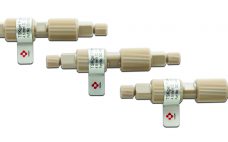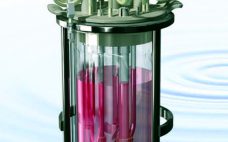This webcast features: Vincent Monchois, Strategic Project Director, Biopharma, Novasep Challenges in bio-manufacturing up to commercial stage include improving lead times, securing the process, improving productivity, and reducing COGs. The implementation of a continuous manufacturing process is a viable solution to address these challenges. The chromatography step represents one of the key stages of a manufacturing process for (bio)pharmaceutical compounds. Continuous chromatography was originally developed by the Petroleum industry in the 1960s and has been successfully implemented in the Food-processing…
Sponsored Content
Fast monoclonal antibody titer determination with the TSKgel® Protein A-5PW column
The antibody therapeutics market is enjoying high growth rates, the major areas of therapeutic application being cancer and immune/inflammation-related disorders. Six of the top ten best-selling global drug brands are monoclonal antibody-based. This market is predicated to show continued growth for many years to come, with more monoclonal antibodies (mAbs) designed and produced for treatments of specific diseases. Early in mAb development there are many harvested cell supernatant samples which contain mAbs that are secreted by cell cultures. These samples…
Special Report: GE Bioprocess Insights
Introduction Accelerate activity. Improve predictability. Drive higher process efficiency. Increase quality. Lower cost of goods sold (CoGS). Secure supply. In an era where the biomanufacturing wheels turn faster by the day, where the stakes are higher and the choices seemingly endless, it is easy to become overwhelmed. How can you make good biomanufacturing decisions and develop robust long-term strategies when the environment is constantly changing? Whether a political shift affects your product or market, a natural disaster disrupts your supply…
Acceleration of Bioprocess Development Using DoE and Physiological Control
This webcast features: Professor Christoph Herwig, Department of Biochemical Engineering, Vienna University of Technology Bioprocess Development for biotechnological high value added products is still a time consuming task. The reason for this is the high complexity of interdependence between process variables, product quality attributes and process parameters. The demonstration of understanding these interdependencies is however key to achieve regulatory acceptance according to Quality by Design (QbD) principles. Hence, it is important to set up senseful experiments and to gather as…
Getting Big Benefits from Small Components
Like a chain, a biopharma transfer system depends on each of its links being strong enough to protect the integrity of the materials being transferred. In order to prevent problems associated with contamination, the system must be able to maintain a pure environment. Container closures and stopper systems are sometimes seen as small items, but choosing the right components is vital. The impact of specifying the appropriate closure or stopper system can be felt throughout an entire fluid transfer process.…
How to Boost Profits with Single-Use Powder Transfer
This webcast features: Chris Rombach, Director of Global Strategic Accounts, ILC Dover Biopharmaceutical manufacturers face a number of challenges. Open-suite biopharma manufacturing is gaining popularity. But it also leaves surfaces open to contamination, workers at risk for exposure to airborne particulates, and processes more exposed to product loss due to waste or spillage. Liquid handling systems adapted for dry powder applications are often a compromise, because liquid and powder flow rates, handling characteristics and dispensing volumes differ dramatically. A purpose-built,…
Principles and Troubleshooting of Large Scale Column Packing
This webcast features: J. Kevin O’Donnell, PhD, Process Chromatography Support Manager, Tosoh Bioscience This presentation focuses on the packing of process scale chromatography columns. Including general principles of column packing, common packing techniques used in packing process scale columns, qualification and evaluation of the packed column, and the troubleshooting of issues common to large scale column packing.
Deciding Between Single-Use and Stainless Steel Strategies
A BPI Theater Roundtable at Interphex 2016 On Tuesday, 26 April 2016, Eric S. Langer (managing partner of BioPlan Associates) chaired a morning roundtable titled “Deciding on Single-Use vs. Stainless Steel Strategy: What the CMOs Know That Biopharma Needs” as a follow-up to a similar discussion held last year. Langer brought together a panel of four contract manufacturing organization (CMO) industry experts: Daniel Vellom (senior director of global technology innovation at Sanofi Pasteur) Sue Behrens (senior director of process technology…
Coordination of Single-Use System Standards and Best-Practice Efforts
A BPI Theater Roundtable at Interphex 2016 On Tuesday, 26 April 2016, James D. Vogel (founder and director of The BioProcess Institute at the University of Rhode Island) chaired a midday roundtable titled, “Single-Use Harmonization Town Hall: Coordination of SUS Standards and Best Practice Efforts.” Two industry experts joined him in a panel discussion: Mike Johnson (business development engineering manager for Entegris) Jeff Carter (strategic projects leader at GE Healthcare). All three are members of different groups interested in developing…
Single-Use Benchtop Bioreactor System for Mammalian Cell Culture and Recombinant Protein Production
Mark Arjona (product line manager, Distek) 1:00–1:20 pm The bioprocessing industry has embraced single-use technologies recognizing their benefits of safety, cost, and throughput. Based in New Jersey, Distek is a leading manufacturer of single-use equipment. The BIOne is a single-use bioreactor system consisting of a patent-pending, disposable headplate and liner that fit together into a bench-scale glass vessel. The liner molds to the contours of culture vessels (3 L or 7 L), keeping their geometry, aspect ratio, and volume all…










